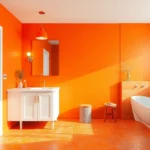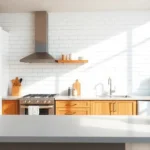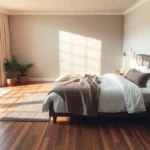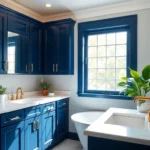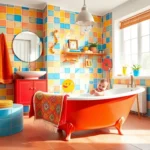Sage green has taken the design industry by storm and we’re absolutely loving how this calming hue transforms kitchens into sophisticated spaces. This earthy tone strikes the perfect balance between nature-inspired tranquility and contemporary elegance making it an ideal choice for homeowners seeking both style and serenity in their culinary haven.
We’ve discovered that sage green isn’t just another passing trend – it’s a versatile color that works beautifully with various design styles from modern farmhouse to minimalist chic. Whether you’re planning a complete kitchen renovation or simply looking to refresh your space with strategic updates this timeless shade offers endless possibilities for creating your dream kitchen.
From painted cabinets and subway tiles to accent walls and decorative accessories we’ll explore creative ways to incorporate sage green into your kitchen design. Get ready to discover how this sophisticated color can elevate your cooking space while maintaining that warm welcoming atmosphere every kitchen deserves.
Sage Green Kitchen Cabinets That Transform Your Space
Sage green cabinets serve as the cornerstone of this sophisticated design trend, offering endless possibilities to create your dream kitchen. We’ve discovered that these versatile cabinets work beautifully as standalone statements or paired with complementary colors to achieve stunning visual impact.
Upper and Lower Cabinet Color Combinations
Cream and sage green combinations create the most popular two-tone approach we see in modern kitchens. Upper cabinets in warm cream or off-white tones paired with sage green base cabinets establish a balanced, airy feel that makes spaces appear larger and more inviting.
White upper cabinets with sage green lowers deliver classic elegance that never goes out of style. This combination maximizes natural light reflection from upper areas while grounding the space with the calming sage green foundation below.
Natural wood uppers paired with sage green base cabinets bring organic warmth to contemporary kitchens. Oak, maple, or walnut upper cabinets create beautiful contrast against sage green lowers, establishing a connection between indoor spaces and nature.
Navy blue and sage green pairings offer bold sophistication for homeowners seeking dramatic impact. Deep navy upper cabinets combined with sage green base units create striking visual depth while maintaining an elegant, timeless appeal.
Two-Tone Cabinet Designs
Island contrast designs transform kitchen islands into stunning focal points using sage green cabinets against neutral perimeter cabinetry. We recommend using sage green for islands when surrounding cabinets are white, cream, or light gray to create intentional design hierarchy.
Vertical split applications divide wall space between upper and lower cabinets using different sage green intensities. Lighter sage tones on upper cabinets paired with deeper sage shades on lower units create sophisticated depth without overwhelming smaller kitchen spaces.
Accent cabinet highlighting incorporates sage green selectively on exact cabinet sections like pantry units, coffee stations, or display areas. This approach allows you to introduce the color gradually while maintaining flexibility for future design changes.
Mixed finish combinations blend painted sage green cabinets with stained wood elements throughout the same kitchen. Painted sage green on most cabinets with natural wood accents on islands or open shelving creates layered visual interest.
Hardware Selection for Sage Green Cabinets
Brass hardware complements sage green cabinets beautifully, creating warm, inviting atmospheres that feel both modern and timeless. Unlacquered brass develops natural patina over time, adding authentic character to your sage green kitchen design.
Black matte finishes provide striking contrast against sage green cabinet surfaces, establishing bold, contemporary looks that work especially well in modern farmhouse and industrial kitchen styles.
Brushed nickel options offer subtle sophistication without competing with sage green’s natural beauty. This neutral metallic choice works seamlessly with both warm and cool color palettes throughout your kitchen space.
Oil rubbed bronze creates rich, traditional appeal when paired with sage green cabinets in rustic or vintage-inspired kitchen designs. The dark, weathered finish adds depth and character to cabinet doors and drawers.
| Hardware Finish | Best Sage Green Shade | Design Style | Durability Rating |
|---|---|---|---|
| Unlacquered Brass | Light to Medium Sage | Modern Farmhouse | 8/10 |
| Matte Black | All Sage Tones | Contemporary/Industrial | 9/10 |
| Brushed Nickel | Medium to Dark Sage | Transitional | 9/10 |
| Oil Rubbed Bronze | Dark Sage | Rustic/Traditional | 7/10 |
Sage Green Kitchen Islands as Statement Pieces

Transform your kitchen with a sage green island that commands attention and serves as the room’s natural focal point. These striking centerpieces provide fresh contrast against surrounding cabinetry while maintaining the calming aesthetic that makes sage green so popular in contemporary design.
Waterfall Edge Designs
Waterfall edges elevate sage green islands by extending the countertop material down the vertical sides to create a seamless, sophisticated look. This modern technique enhances the island’s architectural presence while delivering the luxurious feel that homeowners crave. We love how the continuous material flow from horizontal surface to floor creates visual drama without overwhelming the space’s serene atmosphere.
Choose materials like quartz or marble that complement Benjamin Moore’s October Mist paint, ensuring the waterfall edge maintains consistency with your sage green base. The silvery green hue adapts beautifully to various lighting conditions, making your waterfall island a stunning centerpiece throughout the day.
Contrasting Countertop Materials
Contrasting countertops add essential depth and visual interest to sage green islands while balancing the muted earth tones. We recommend white marble for classic elegance, quartz for durability, butcher block for warmth, or dark stone surfaces for dramatic impact. These materials bring out the natural warmth in your sage green base while creating sophisticated color layering.
Pair your sage green island with lighter countertops to brighten the space or choose darker materials to ground the design with rich contrast. Each option enhances the island’s role as a statement piece while supporting the overall kitchen aesthetic.
Built-In Storage Answers
Built in storage maximizes functionality while preserving the clean, uncluttered appearance that makes sage green kitchens so appealing. Custom cabinetry, pull out drawers, and hidden compartments seamlessly integrate into your island design without disrupting the visual flow. We prioritize these answers because they minimize visual noise while supporting everyday practicality.
Consider integrated appliances like wine coolers or dishwasher drawers that disappear into your sage green island’s design. These smart storage features maintain the serene, cohesive look while ensuring your statement piece serves as both beautiful focal point and hardworking kitchen hub.
Sage Green Backsplash Ideas for Modern Kitchens

Building on the foundation of sage green cabinetry and islands, we’ll explore how sage green backsplashes can transform your kitchen’s visual impact. These versatile designs complement various materials while maintaining the sophisticated atmosphere we’ve established.
Subway Tile Variations
Classic subway tiles in sage green deliver clean lines with subtle color infusion that modernizes traditional kitchen layouts. We recommend arranging these tiles in herringbone patterns to add visual texture without overwhelming the space. Vertical stacking creates height emphasis in kitchens with lower ceilings, while traditional brick patterns maintain timeless appeal.
Pairing sage subway tiles with white cabinetry creates fresh contrast that brightens the entire cooking area. Natural wood accents enhance the earthy quality of sage green, establishing a warm connection between organic materials. Brass hardware selections amplify the sophisticated look, creating cohesive design flow throughout your kitchen.
Different grout colors can dramatically alter the subway tile’s visual impact. Light gray grout maintains subtle definition between tiles, while white grout creates seamless flow. Dark grout options add bold contrast that emphasizes the tile pattern and creates architectural interest.
Natural Stone Options
Natural stone tiles in light sage tones bring luxurious texture through marble and quartzite selections. Veined surfaces introduce organic movement that complements the calming sage palette. Honed finishes provide subtle sophistication while maintaining the stone’s natural character.
Sage green marble backsplashes harmonize beautifully with both light and dark countertop materials. We’ve observed that these natural stones create balanced designs when paired with white quartz or butcher block surfaces. The color variation within natural stone prevents monotonous appearance while preserving design cohesion.
Quartzite options offer durability advantages over traditional marble while maintaining similar aesthetic appeal. These stones resist staining and etching better than marble alternatives. Installation typically requires professional expertise due to the material’s weight and cutting requirements.
Painted Glass Backsplashes
Painted glass surfaces in sage green deliver sleek contemporary finishes that reflect light throughout modern kitchens. The reflective properties brighten cooking spaces while providing easy maintenance benefits. We recommend this option for minimalist designs where clean lines take priority.
Stainless steel appliances pair exceptionally well with sage green painted glass, creating industrial elegance. Matte fixture selections maintain the sophisticated atmosphere without competing for visual attention. The smooth surface requires minimal cleaning effort compared to textured alternatives.
Custom color matching ensures perfect coordination with existing sage green elements in your kitchen design. Professional installation guarantees seamless edges and proper mounting. The non porous surface resists moisture and grease absorption, making maintenance straightforward for busy households.
Sage Green Kitchen Walls and Paint Techniques

Beyond cabinets and backsplashes, sage green wall treatments offer endless possibilities to transform your kitchen’s atmosphere. We’ll explore strategic approaches that maximize visual impact while maintaining the sophisticated charm this versatile hue brings to any culinary space.
Accent Wall Strategies
Focus on a single wall to create a dramatic focal point that draws attention to exact kitchen areas like your cooking station or dining nook. Painting one wall in sage green allows you to experiment with this trending color without overwhelming the entire space.
Combine with other greens for a harmonious natural palette that brings outdoor tranquility indoors. Soft forest greens, mint tones, and deeper olive shades work beautifully alongside sage green to create layered depth and visual interest.
Apply sage green paint to vertical shiplap walls for a unified farmhouse inspired look that adds texture and character. Contrast this treatment with white trim, natural wood accents, and woven accessories to enhance the overall design impact.
Use light sage green paint on kitchen walls paired with elongated ceramic tiles running full height to achieve a modern eclectic aesthetic. This combination creates a serene vibe while adding sophisticated texture that complements contemporary kitchen designs.
Complementary Color Palettes
Pair sage green kitchen walls with soft gray tones for a timeless and sophisticated color scheme that never goes out of style. Marble floor tiles elevate this combination while maintaining perfect harmony between cool and warm undertones.
Combine sage green with light oak furniture or wicker accessories to create a cozy, inviting atmosphere that feels both natural and refined. This pairing works especially well in kitchens with abundant natural light.
Balance sage green walls with crisp white trim and cabinetry to create classic contrast that brightens the space. White countertops and subway tile backsplashes amplify this fresh, clean aesthetic.
Incorporate warm brass fixtures and hardware to add golden undertones that complement sage green’s natural warmth. This combination creates a sophisticated palette reminiscent of traditional English country kitchens.
Textured Paint Finishes
Use a matte paint finish to avoid reflecting harsh light and create a subtle, calming effect that’s perfect for sage green walls. Matte finishes hide imperfections while providing rich color depth that enhances the sophisticated appearance.
Apply a distressed finish to add texture and visual depth that creates unique character in your sage green kitchen walls. This technique works particularly well in farmhouse or rustic kitchen designs where weathered charm is desired.
Consider limewash techniques for sage green walls that want authentic texture and movement. This finish creates subtle color variations that add organic appeal while maintaining the serene qualities sage green is known for.
Experiment with color washing to blend sage green with lighter or darker tones for walls that appear to have natural depth. This technique creates sophisticated layering that changes appearance throughout the day as lighting shifts.
Sage Green Kitchen Accessories and Decor

Accessories and decor elements bring sage green kitchens to life by adding layers of texture, functionality, and visual interest. We’ll explore how strategic coordination across appliances, textiles, and natural elements creates a cohesive design that celebrates this versatile hue.
Small Appliance Coordination
Stainless steel appliances create the perfect balance with sage green cabinetry without competing for attention. These metallic finishes reflect light beautifully and maintain the kitchen’s sophisticated atmosphere while offering timeless appeal.
Copper appliances introduce warm undertones that enhance sage green’s natural earthiness. Stand mixers, coffee makers, and toasters in copper finishes add visual warmth and create stunning focal points on countertops.
White appliances provide classic elegance that pairs effortlessly with sage green elements. Cream colored options offer similar benefits while adding subtle warmth that complements the green’s natural undertones.
Black matte finishes deliver contemporary contrast that makes sage green cabinets pop. These sleek appliances work particularly well in modern farmhouse or minimalist kitchen designs where bold contrasts create visual drama.
Textile and Fabric Choices
Linen fabrics bring natural texture that amplifies sage green’s organic appeal. Window treatments, table runners, and chair cushions in natural linen create seamless flow between indoor and outdoor environments.
Cotton textiles offer versatility and easy maintenance while maintaining the kitchen’s relaxed atmosphere. We recommend choosing cotton in complementary neutral tones like cream, soft gray, or warm white.
Subtle stripe patterns add visual interest without overwhelming the space’s calming nature. These designs work beautifully in sage green kitchens when executed in muted colors that echo the overall palette.
Soft floral motifs introduce gentle movement and organic shapes that reinforce the natural theme. Choose patterns with sage green accents or complementary earth tones to maintain design cohesion.
Plant and Greenery Integration
Herb gardens provide both functionality and visual appeal when displayed in decorative planters. Basil, rosemary, and thyme create living accents that enhance the kitchen’s natural ambiance while offering fresh ingredients for cooking.
Potted plants transform sage green kitchens into serene retreats that blur indoor outdoor boundaries. Choose varieties like snake plants, pothos, or peace lilies that thrive in kitchen environments and complement the green color scheme.
Living walls create dramatic focal points that celebrate the natural industry. These vertical gardens work particularly well in larger kitchens where they can serve as stunning backdrops for dining areas or breakfast nooks.
Greenery arrangements in ceramic or wooden vessels add organic texture throughout the space. Mix different shades of green foliage to create depth while maintaining harmony with sage green design elements.
Sage Green Kitchen Lighting Solutions

Strategic lighting choices can transform your sage green kitchen into a perfectly illuminated culinary haven. We’ll explore three essential lighting categories that enhance the natural beauty of sage green while providing optimal functionality.
Pendant Light Selections
Brushed brass pendants create stunning focal points above sage green kitchen islands, offering warm metallic contrast that elevates the earthy palette. We recommend clustering two or three matching pendants to achieve balanced task lighting and visual impact.
Matte black fixtures provide bold contrast against sage green cabinetry, creating a modern farmhouse aesthetic that feels both contemporary and timeless. These darker tones ground the space while maintaining the sophisticated atmosphere.
White glass pendants offer clean, minimalist appeal that complements sage green’s natural freshness without competing for attention. Their translucent quality diffuses light beautifully throughout the cooking area.
Natural wood or rattan pendants amplify the organic feel of sage green kitchens, reinforcing the connection to nature through complementary materials. These textured fixtures add warmth and character while maintaining the earthy design theme.
Under-Cabinet Lighting Options
LED strip lights installed beneath sage green cabinets deliver bright, even illumination for food preparation and counter work. We suggest choosing warm white or soft yellow tones to preserve the inviting atmosphere while ensuring adequate task lighting.
Puck lights create focused illumination pools that highlight the beauty of sage green cabinetry and backsplashes below. These compact fixtures work particularly well in kitchens with varying cabinet depths and configurations.
Linear LED fixtures provide seamless lighting answers that enhance both functionality and aesthetics in sage green kitchens. Their sleek profile maintains clean lines while delivering consistent illumination across entire counter spans.
Natural Light Enhancement
Large windows and skylights allow daylight to flood sage green kitchens, bringing out the true vibrancy of this versatile hue throughout the day. We recommend maximizing these architectural features to create bright, airy spaces that feel connected to the outdoors.
Glass doors extend natural light penetration while maintaining the open, fresh feeling that complements sage green’s calming properties. These transparent barriers preserve sight lines and enhance the overall sense of space.
Sheer or translucent window treatments diffuse harsh sunlight without obstructing natural illumination, ensuring sage green surfaces remain vibrant and fresh. We favor these lightweight options over heavy drapery that might diminish the color’s natural appeal.
| Lighting Solution | Key Features | Best Applications |
|---|---|---|
| Pendant Lights | Brushed brass, matte black, white glass, natural materials | Island task lighting, focal points |
| Under-Cabinet Lighting | LED strips, puck lights, warm white tones | Counter illumination, cabinet highlighting |
| Natural Light | Windows, skylights, glass doors, sheer treatments | Overall brightness, color enhancement |
Sage Green Kitchen Countertop and Surface Ideas

Selecting the right countertop materials can elevate your sage green kitchen design while providing durability and functionality. We’ll explore three distinct approaches that complement this versatile color palette perfectly.
Marble and Quartz Pairings
Marble countertops create an elegant foundation when paired with sage green cabinets, particularly in white or light gray variations with subtle veining. Natural marble’s organic patterns enhance the calming nature of sage green while adding luxurious appeal to both traditional and contemporary kitchen designs.
Quartz surfaces offer similar visual benefits with enhanced durability for high-traffic kitchens. These engineered surfaces maintain consistent coloring and resist stains better than natural stone, making them ideal for busy households. White and light gray quartz options provide the same sophisticated contrast as marble while requiring less maintenance.
Both materials work exceptionally well in sage green kitchens because their neutral tones allow the green hue to remain the focal point without competing for attention.
Butcher Block Combinations
Natural wood countertops introduce warmth and texture that beautifully balances sage green’s cool undertones. Oak and maple butcher block surfaces are particularly popular choices due to their durability and attractive grain patterns.
Wood’s organic appearance creates visual harmony with sage green’s nature-inspired palette while adding tactile interest to kitchen surfaces. This combination works especially well in farmhouse and transitional kitchen styles where natural materials take center stage.
Mixed applications often prove most effective, such as installing butcher block on kitchen islands while using marble or quartz for perimeter counters. This approach maximizes both function and style while creating distinct work zones within your sage green kitchen.
Concrete and Industrial Finishes
Concrete countertops bring modern, urban aesthetics to sage green kitchens through their matte finish and neutral gray tones. These surfaces highlight sage green’s subtle undertones while providing an industrial edge that works well in contemporary designs.
Industrial finishes extend beyond countertops to include exposed metals and matte hardware that complement concrete’s raw appeal. Black matte fixtures and brushed steel elements enhance this modern aesthetic while maintaining visual cohesion with sage green cabinetry.
Concrete backsplashes can extend this industrial theme throughout the kitchen, creating a cohesive design that feels both sophisticated and cutting edge. The material’s versatility allows for custom shaping and finishing techniques that add unique character to your sage green kitchen space.
Sage Green Kitchen Design Styles and Themes

Sage green adapts beautifully to various design aesthetics, making it one of the most versatile color choices for kitchen renovations. We’ll explore three distinct approaches that showcase how this sophisticated hue transforms different kitchen styles.
Farmhouse and Rustic Approaches
Light sage green kitchen walls create the perfect foundation for farmhouse charm, establishing a warm and inviting atmosphere that feels both fresh and timeless. Natural materials like reclaimed wood beams, butcher block countertops, and stone flooring complement sage green beautifully, improving the rustic appeal.
Woven baskets serve as both storage and decorative elements, adding texture while maintaining the organic farmhouse theme. Vintage metalware pieces, such as galvanized containers and copper pots, introduce authentic character that pairs perfectly with sage green’s earthy undertones.
Exposed shelving in natural wood tones allows sage green dishware and mason jars to become part of the decor. Distressed finishes on sage green cabinet doors add weathered charm that’s essential to the farmhouse aesthetic.
Modern Minimalist Concepts
Sage green cabinets paired with white countertops and gray floors create a sleek, contemporary look that feels both sophisticated and serene. Clean lines throughout the design maintain the minimalist aesthetic while sage green adds natural elegance without overwhelming the space.
Handleless cabinet doors in sage green contribute to the streamlined appearance, eliminating visual clutter that’s crucial in minimalist design. Integrated appliances maintain the seamless look while allowing the sage green color to remain the focal point.
Simple pendant lights with geometric shapes enhance the modern feel without competing with the sage green cabinetry. White subway tiles or seamless backsplashes keep the color palette clean and focused.
Traditional and Classic Interpretations
Sage green kitchen cabinets combined with soft gray tones and marble floors create a timeless, sophisticated look that never goes out of style. Classic proportions in cabinet design, such as raised panel doors and traditional crown molding, enhance the refined appearance.
Brass hardware adds warmth and elegance to sage green cabinets, creating the perfect balance between classic and contemporary elements. Ornate lighting fixtures, such as crystal chandeliers or traditional lantern pendants, complement the sophisticated color palette.
Marble countertops with subtle veining provide the perfect neutral backdrop for sage green cabinetry while maintaining the classic aesthetic. Traditional accessories like ceramic canisters and vintage-inspired faucets complete the timeless look.
Conclusion
Sage green kitchens offer endless possibilities for creating spaces that are both beautiful and functional. We’ve explored how this versatile hue transforms every element from cabinets and islands to lighting and countertops making it clear why it’s become such a beloved choice among homeowners.
What makes sage green truly special is its ability to adapt to your personal style whether you’re drawn to farmhouse charm modern minimalism or classic elegance. The color’s natural calming properties combined with its sophisticated appeal ensure your kitchen will remain timeless for years to come.
Ready to embrace this trend? Start small with accessories and paint samples or go bold with sage green cabinetry and backsplashes. Your dream sage green kitchen awaits and we’re confident you’ll love the serene yet stylish atmosphere it creates.
Frequently Asked Questions
What makes sage green a good choice for kitchen design?
Sage green creates a sophisticated and calming atmosphere in kitchens while offering remarkable versatility. It works beautifully with various design styles, from modern farmhouse to minimalist chic, and isn’t just a fleeting trend but a timeless color choice that enhances cooking spaces while maintaining a warm, inviting ambiance.
What colors pair well with sage green kitchen cabinets?
Sage green cabinets pair beautifully with cream, white, natural wood, and navy blue to create stunning visual impacts. These combinations work well in two-tone cabinet designs, contrasting islands, and accent highlighting, offering flexibility to match your preferred design aesthetic.
What hardware finishes complement sage green cabinets?
Brass, black matte, brushed nickel, and oil-rubbed bronze all complement sage green cabinets effectively. Each finish contributes to different design styles and atmospheres – brass for warmth, black matte for modern appeal, brushed nickel for versatility, and oil-rubbed bronze for rustic charm.
How can I use sage green kitchen islands as focal points?
Sage green kitchen islands serve as stunning statement pieces that provide fresh contrast against surrounding cabinetry. Consider waterfall edge designs with quartz or marble surfaces, and pair with contrasting countertop materials like white marble, butcher block, or dark stone for added visual interest and depth.
What backsplash options work with sage green kitchens?
Classic subway tiles in sage green arranged in herringbone or vertical patterns enhance the space’s aesthetic. Natural stone options like marble and quartzite add luxurious texture, while painted glass backsplashes offer a sleek, contemporary choice that reflects light and provides easy maintenance.
How should I approach sage green wall treatments?
Create accent walls to draw attention to specific areas, combine sage green with other greens for a natural palette, and use textured finishes like matte or distressed paint for character. Pair with soft grays, light oak, and crisp whites to enhance the overall design harmony.
What accessories complement sage green kitchens?
Coordinate small appliances in stainless steel, copper, white, or black matte finishes. Choose linen and cotton textiles for window treatments, incorporate subtle patterns and floral motifs, and add plants like herb gardens, potted plants, or living walls to enhance the natural ambiance.
What lighting works best with sage green kitchens?
Pendant lights in brushed brass, matte black, white glass, or natural wood/rattan complement sage green beautifully. Under-cabinet LED strip lights and puck lights provide task illumination, while maximizing natural light through large windows and skylights creates bright, airy spaces.
What countertop materials pair well with sage green?
Marble and quartz provide elegant, low-maintenance options that complement sage green. Butcher block introduces warmth and texture, while concrete and industrial finishes add modern appeal with a contemporary edge. Choose based on your desired aesthetic and maintenance preferences.
What design styles work with sage green kitchens?
Sage green adapts to farmhouse/rustic styles with natural materials and vintage elements, modern minimalist approaches with clean lines, and traditional classic designs with soft grays and marble. The color’s versatility allows it to enhance various aesthetics while maintaining timeless appeal.


